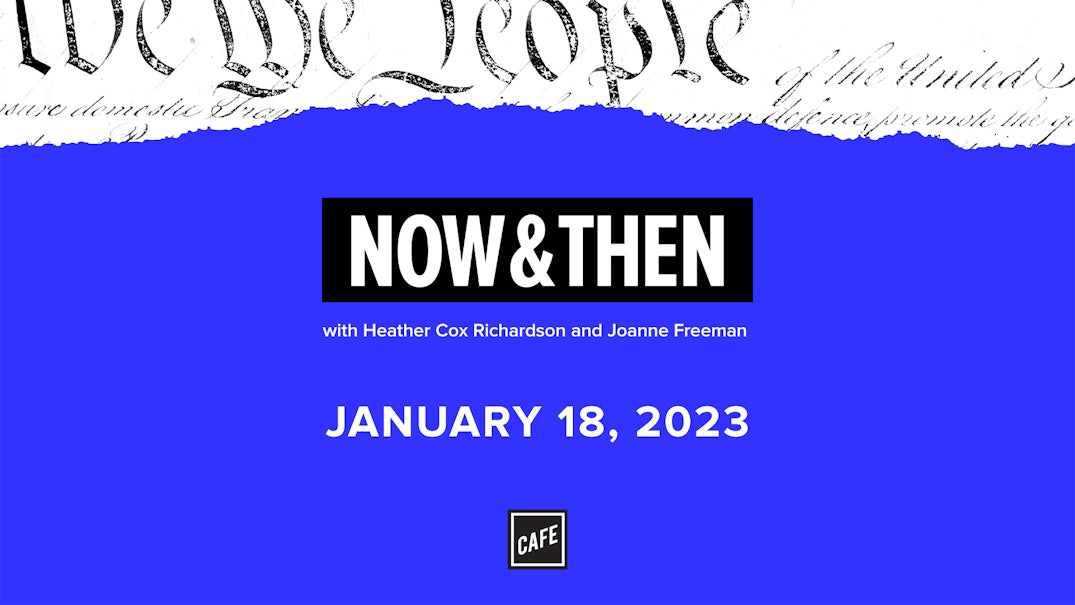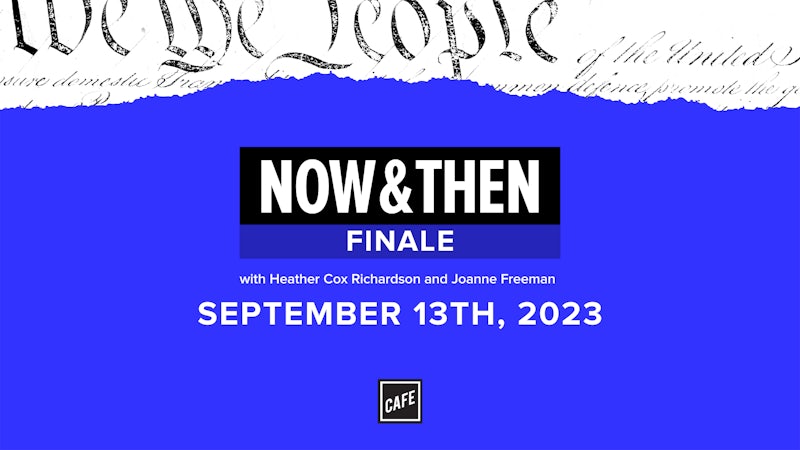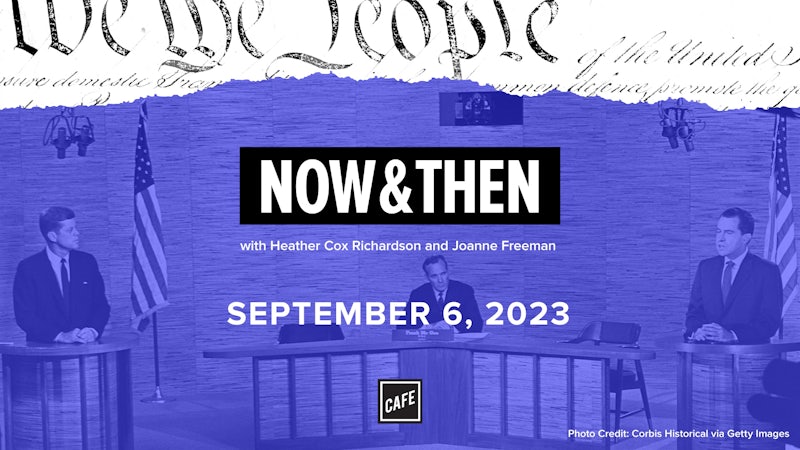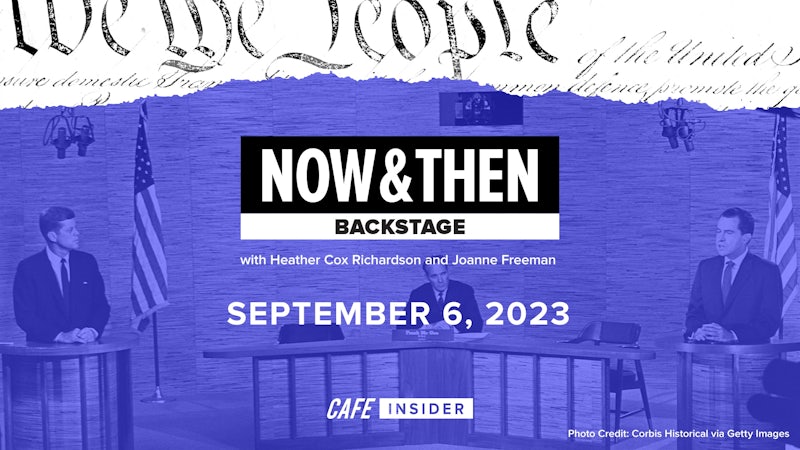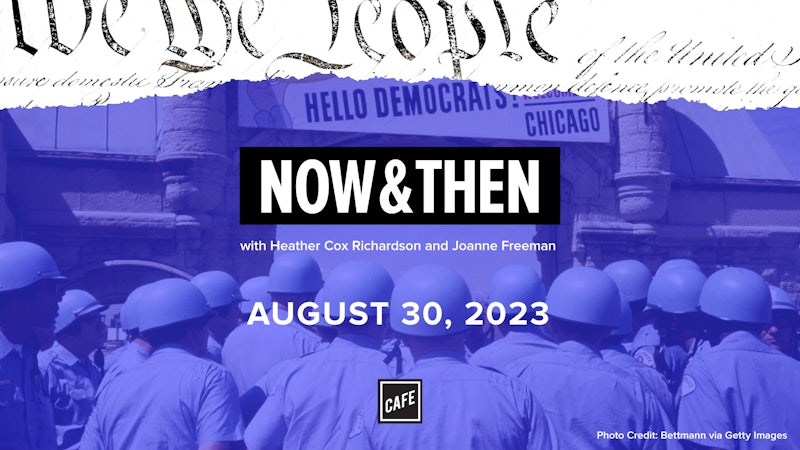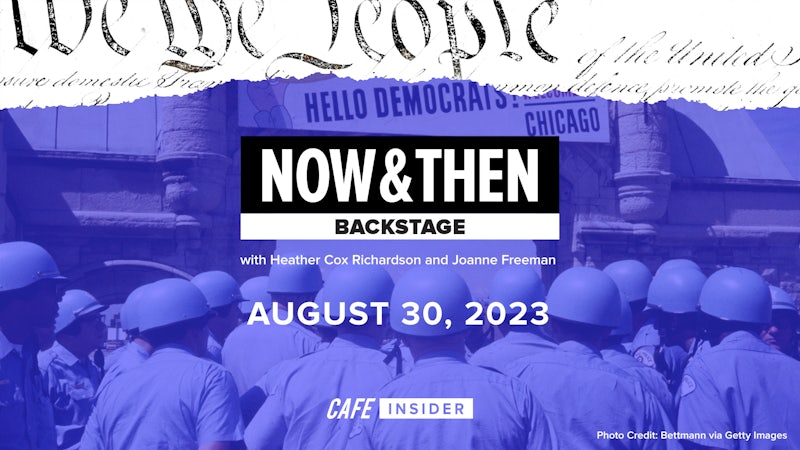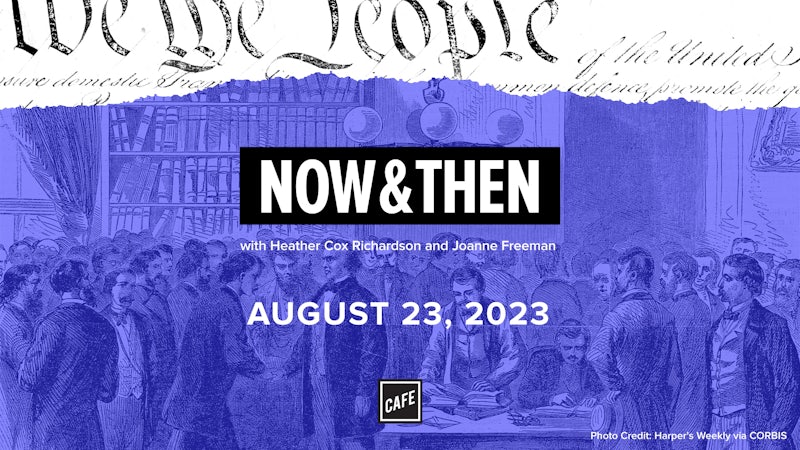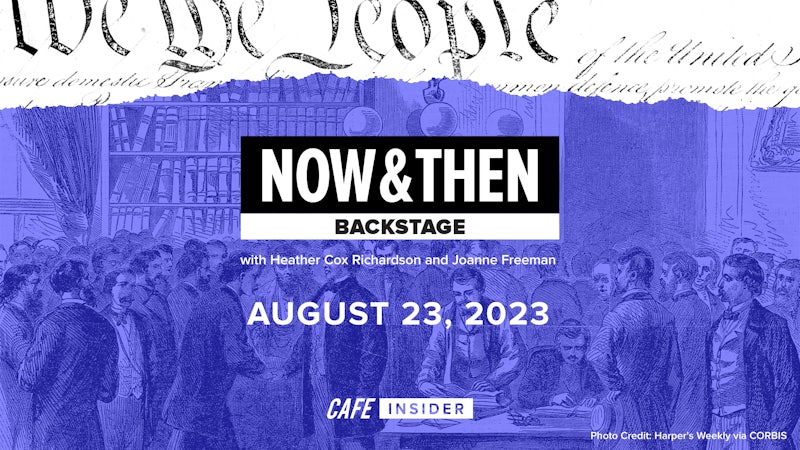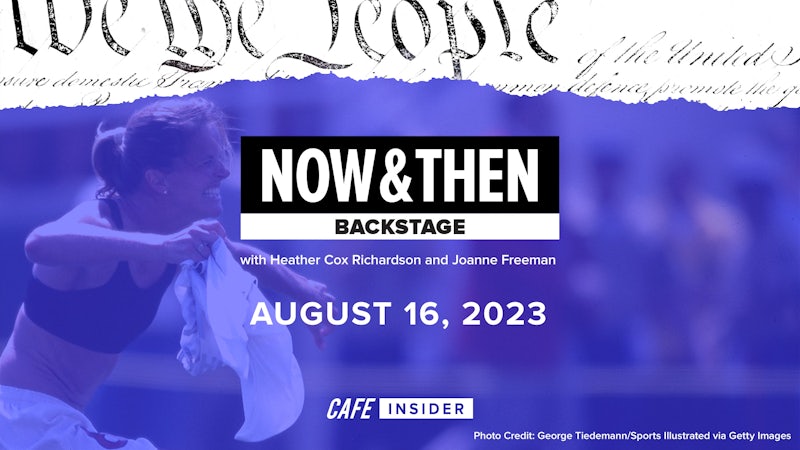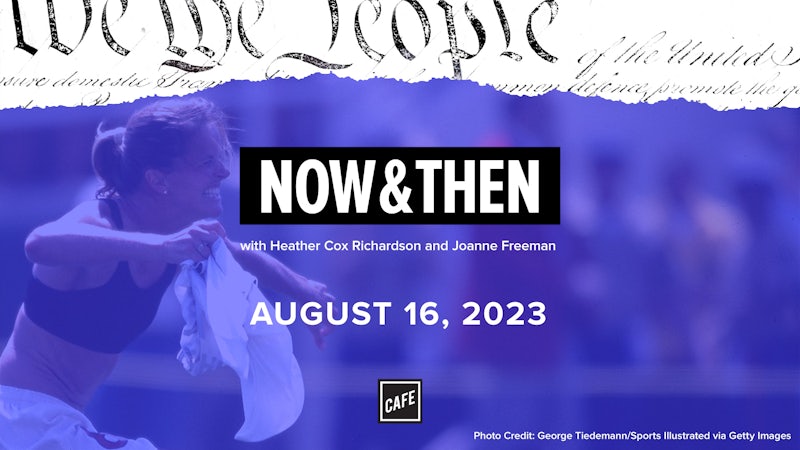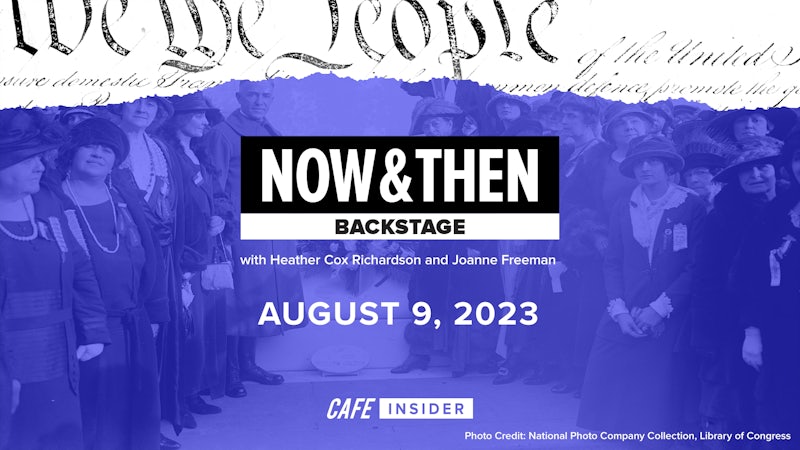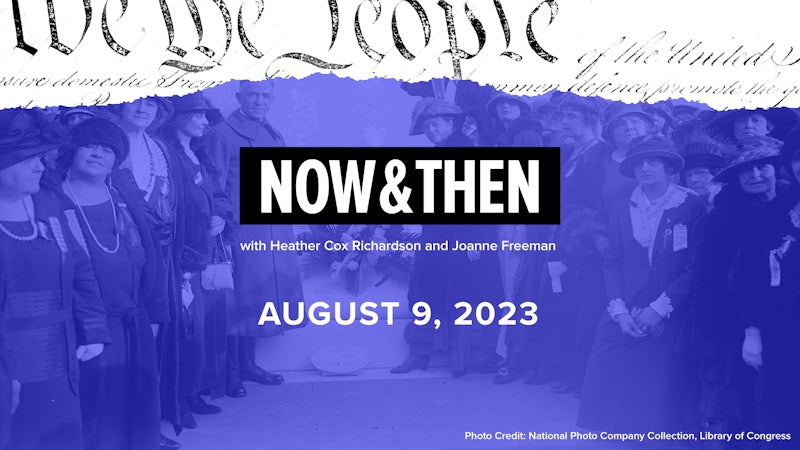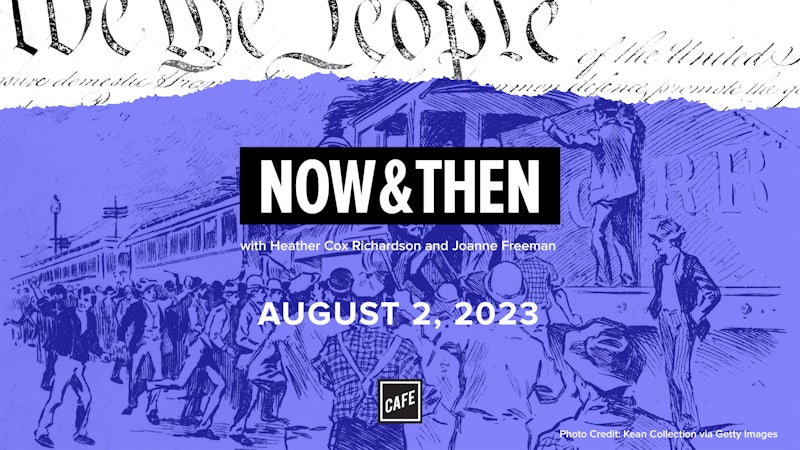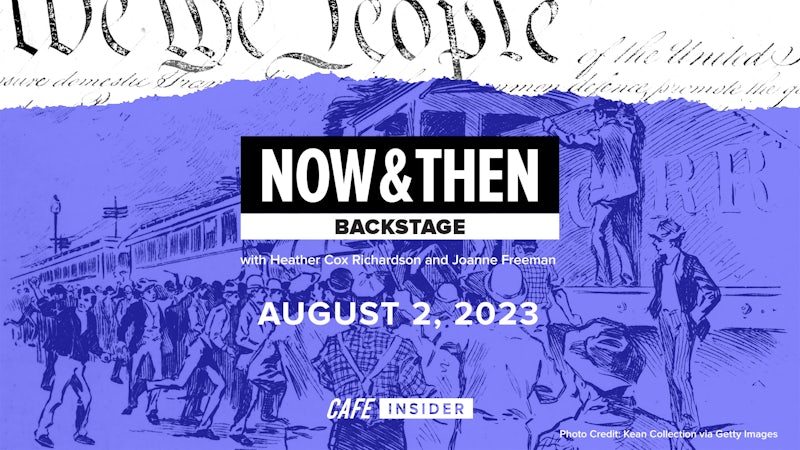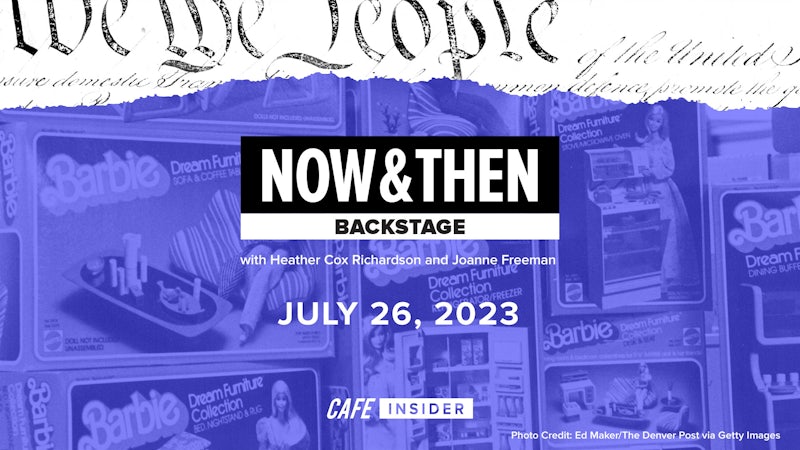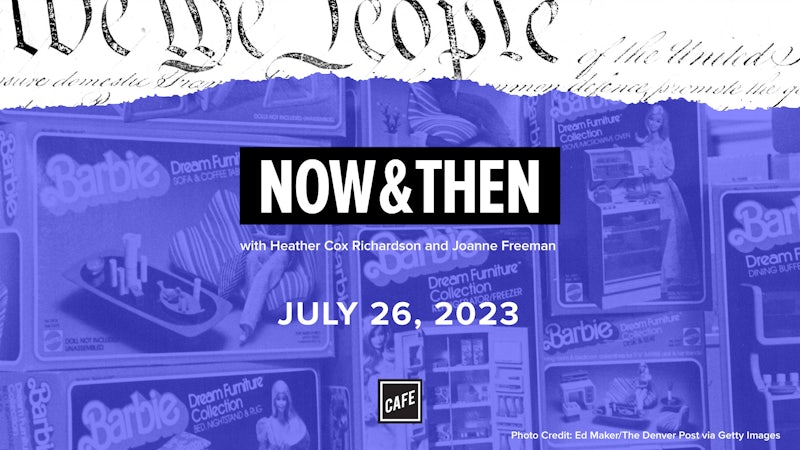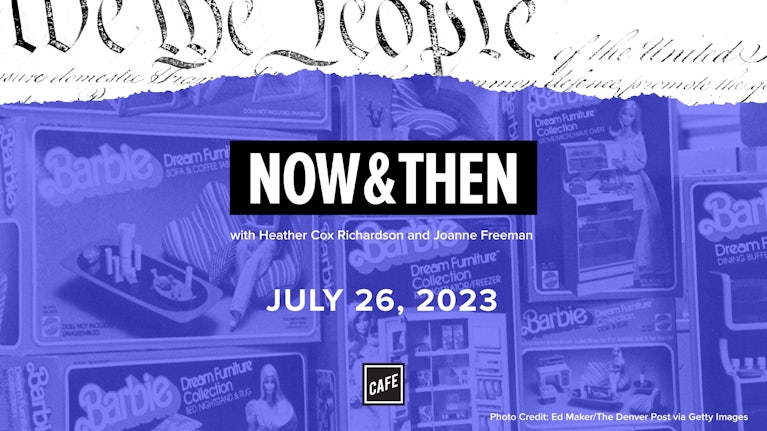Heather Cox Richardson:
From CAFE and the Vox Media Podcast Network, this is Now and Then. I’m Heather Cox Richardson.
Joanne Freeman:
And I’m Joanne Freeman. Today we’re going to talk about a topic that I’m guessing many people listening have some connection to, possibly because of the pandemic. And the topic is pets. In some ways, given the pandemic, we’ve seen a shift in the way people are interacting with pets, the percentage of people who have pets. So the last three years have brought what some people are calling a pandemic pet boom. Apparently, more than 23 million American households, nearly one in five nationwide, adopted a pet during the pandemic, according to the ASPCA, the American Society for the Prevention of Cruelty to Animals. And I am one of them. I have my parakeet, Newbie, the history bird, who I got towards the beginning of the pandemic.
Heather Cox Richardson:
I did not realize Newbie was a pandemic bird.
Joanne Freeman:
Newbie was a pandemic bird, but he was a rescue pandemic bird. He was found in Central Park for September of the pandemic. Who knew?
Heather Cox Richardson:
I feel like he’s been with us forever.
Joanne Freeman:
Because he’s part of the gang.
Heather Cox Richardson:
That’s right.
Joanne Freeman:
At any rate, pets are a thing that many people have been thinking about, particularly me, ways in which people have owned animals and treated them as pets or not treated them as pets. And what that suggests about how we see ourselves, how we see society.
Heather Cox Richardson:
And how we think about economics. And that always surprises me because when you and I talk so much on this show about democracy and about the ways in which democracy intersects with the economy and with jobs and all the sorts of things we talk about, one of the things that strikes me as we’re talking about pets, that we tend to focus on government and paperwork and banks and labor. And the reality is that animals play a huge part in American society and in American history, and in the American economy. So one of the things that jumps out in this present moment with pandemic pets is that the average household spending on pets rose significantly between 2013 and 2021. In 2013, families spent about $460 on their pets, and that rose to 770 in 2021. And there are also very stark racial divides when it comes to pet ownership in America. According to data that was compiled in 2016 by the American Veterinary Medical Association, about 65% of white households, it’s their descriptive term, own pets and that number was only 37% among black households.
Joanne Freeman:
Now, there are other interesting demographic differences when you look at pet ownership. So for example, this to me is actually not immensely surprising. Women are more likely to own pets than men. These next couple are interesting. Republicans are more likely to own pets than Independents or Democrats. I have no understanding of that, but it’s fascinating. Another interesting demographic there was just that Americans with higher levels of education are less likely to own pets than Americans with lower levels of education. I don’t know what that means, and I won’t take that personally.
Heather Cox Richardson:
It might have something to do with working hours and travel. But what’s interesting about the pandemic pet boom is that almost every age group has seen a significant increase in pet ownership. Particularly, young couples in their twenties and thirties have been a huge driving force behind the pandemic pet boom. And the Washington Post, which did a recent excellent piece on this phenomenon, made the link explicitly between the rise in pet ownership among young couples and the decreasing childbirth rates, suggesting that pets, to some degree, have been taking the place for younger couples of children. So if you look at what pets are doing nowadays, what we had hoped to do today was look back at the role of different kinds of animals in American history and what those animals said about American society at the time.
Joanne Freeman:
Now, before we begin, I do want to start with one thing that will shed light, I think, on everything that we’re going to talk about today. And that is just the origin and meaning of the word pet because we assume, logically enough, pet means domesticated, tamed animal that you keep. But in fact, supposedly the origin of the word may be linked to the French word for little, petite. And it was applied initially in the 16th century to spoiled children, or children treated as a favorite. You’re a pet. In the mid 16th century, it began to include animals and in that case, domesticated or tamed and kept for pleasure or companionship, and became a verb in the 17th century, which is when you can start to be said to pet an animal or to pet someone. Apparently, it didn’t become sexual until the 20th century, and that makes perfect sense. But what’s interesting is that that word begins applied to people and makes its way to pets that are being treated as cuddled, loved favorites, like small children.
Heather Cox Richardson:
Members of the family. And I have heard that, especially in 19th century literature, somebody referring to a child as, “My pet.” I guess I thought the animal nature came first rather than the human. And there’ll be another place where humans and animals are somewhat interchangeable when we’re talking about this. But we decided to start here with a kind of surprise, I think, and that is when cats became so important in America. And one of the reasons that cats become really a defining feature of really the middle of the country and the plains West is because when Euro Americans arrived on the North American continent, one of the things they brought with them was the brown rat. The brown rat is also known as the Norway rat. And almost immediately, the rats did what rats do, which is to infest the local indigenous communities and frontier forts. So in the 1830s, we have a record, believe it or not, of a man who recorded the number of rats he trapped. Joanne is losing it. I love this stuff.
Joanne Freeman:
I have a rodent issue. I’m sorry to all people who have rodent pets, but I literally jump on coffee tables and scream, “Eek”, when there are mice running around. But go on. I’m waiting for the record.
Heather Cox Richardson:
So Joanne should now turn off her headset because in February of 1836, this man caught, I hate to do this to you, Joanne, 89 rats, in February alone. And those, of course are just the ones he caught. So what happens is that the rats start to make their way across the west. They decimate the food supplies. There’s this army essentially of rats coming and eating food. And one military leader in the American West complained that every day rats ate five bushels of the corn supply in his fort. And they tunneled underneath the manmade structures which collapsed. So everything from the earth lodges built by the Mandans, to military forts, are constantly being undermined by these rat tunnels. So once you have this infestation of rats, especially in the plains, that puts an incredible premium on cats. Because if you have a cat, it literally makes the difference between whether or not you’re going to be able to survive in this western environment on the plains especially, or whether you’re going to fail because you’re going to lose your entire food supply.
Joanne Freeman:
Which raises an interesting theme, which is pets on the one hand are companionship and they become members of the family. But in many, many ways, and particularly in their history, they’re tied in with need. So there’s some reason we take in a pet, but sometimes that starts with an animal that is needed and then becomes seen as a member of the family. And I think cats is a great example of that. They were desperately needed. They also become what we now would understand to be a pet.
Heather Cox Richardson:
Very much something that was needed, and then that’s going to become part of the family. So in Arizona territory, in the middle of the 19th century, the price for a cat was $10.
Joanne Freeman:
Which is pretty hefty.
Heather Cox Richardson:
Yeah. Well, the average monthly wage for a laborer was only 20. So basically, half a month’s salary for a cat. And back east in the 19th century, people started to collect the vagrant cats, especially in urban areas and sell them out west. There’s actually a trade in cats going west. Can you imagine? It’s almost like a cat, I can’t believe I’m going to do this, it’s almost like a cat-tle drive.
Joanne Freeman:
Oh man.
Heather Cox Richardson:
I totally made that up. Just so you know, I did not plan that.
Joanne Freeman:
I could see the process in your brain as you stared at me. I have to say, I could see the wheels spinning on that one. Yes.
Heather Cox Richardson:
So the St. Louis dispatch catches onto the idea of the shipments of cats going west, and they argued that the emigration of cats to the west would take pests back east and turn them into something of value in the west. It wrote, instead of living about back doors, uprooting a sustenance from overladen ash barrels and pursuing the occasional and elusive New York rat. The New York cat may go into genuine and steady occupation in the west, have three meals a day and his perpetual fill of gopher meat and be a recognized and laudable member of a thriving community. Interestingly enough, they’re an absolute mirror of the whole idea of go west young man. We’re going to make a man-
Joanne Freeman:
That’s right. But the word there too of a thriving community, right? The cats are going to become a member of a thriving community.
Heather Cox Richardson:
That sort of anthropomorphizing of the cats that are on the frontier comes together in Laura Ingalls Wilder’s cat, Kitty, whom she talks about in Little Town on the Prairie. And Little Town on the Prairie was the seventh book of her mostly autobiographical Little House on the Prairie Series. And the section on Kitty is from their time in De Smet, what became South Dakota in 1881. It was then Dakota Territory. And Laura explains how Pa goes to town and brings home a kitten. And how Kitty, famously named, goes on to be a proper cat. And there’s a lot in this passage. So she says, “Pa had no sooner planted the seed corn than the striped gophers found it.” Now, I would suggest that it’s not just the striped gophers, it’s the rats, but people don’t want to admit that they have rats. So the striped gophers found it. So she sets up the idea that they need a cat by talking about the problems with the gophers in the seed corn.
“So Pa had no sooner planted the seed corn, than the striped gophers found it. All over the field, they had been scampering, stopping to dig into the little spots of fine soil with their tiny paws. It was a wonder that they knew exactly where the kernels were buried. It was amazing that those little gophers, scampering, digging, sitting up straight and nibbling, each one at one kernel of corn held in its paws, had eaten more than half of that whole field of corn. ‘Their pests’, said Pa. ‘I wish we had a cat like old black Susan used to be. She’d have thinned them out.'”
And Kitty becomes central to the survival of the Ingalls family on the plains between the gophers and the rats. She’s an excellent, what they say, mouser, and she becomes central to the family’s economic survival. And also central to the community because Kitty gets quite a reputation for facing down dogs. So that moment in this young adult book that many of us know about being, “Oh look, they got a cat, they got a pet,” is actually really about the historical change-
Joanne Freeman:
The underlying rats.
Heather Cox Richardson:
The historical change on the prairies and the need for economic survival or, as Joanne says, the underlying rats.
Joanne Freeman:
Rats.
Heather Cox Richardson:
But let me just say, I’m actually a fan of the whole rat story because I think it’s really important about environmental change and about economic change and about the human adaptations to those things.
I will also point out that there is a very famous painting from 1845 by George Caleb Bingham, that is called Fur Traders Descending the Missouri. And on this Bingham painting, there’s a couple of fur traders that are in a barge on a very smooth piece of water. And there is an animal in the bow there boat that is chained to the boat. And there’s always been a long conversation about whether that was a fox or a cat. But I think when you know the historical background of both the rats and the cats on the frontier, you can see that not only is this likely to be a cat, but the cats were so important that when George Caleb Bingham painted fur traders. Who traveled with things of value, that they would have had a cat onboard their boat. And it was important enough to them and to him that when he wanted to represent what life actually looked like on the frontier, he included a cat.
Joanne Freeman:
And he assumed the people would understand precisely what that meant. So yeah, for sure. The gopher hunting Western cat became really a kind of fixture in American frontier literature.
So for example, in 1901 children’s author Ruth Tangier Smith published a story in the Youth’s Companion about a lazy California cat named, surprise, Tom. Tom, the cat, who allowed his family’s other cats to do all the work, catching all of the little critters he was supposed to be catching. So this is about Tom the cat. There are three other cats in the family to which Tom belongs, and they’re all very smart. Perhaps that is the reason why Tom is so lazy. He thinks the other cats catch birds and gophers enough for four, while Graybeard, Dyna and Snowball are off hunting, Tom lies asleep in the sun. But when they come back with a nice fat gopher or a tender Blue Jay, why am I reading this?
Tom is very wide awake at once and claims his share of the feast with as much assurance as if he always did his share of the work. I just feel the need to weigh in because Graybeard, Dyna and Snowball, I suppose in the modern day, those would be pretty typical pet names. But as far as names for pets, I looked up a handful when I knew we were going to do this episode because I just wanted to see, are there names you would expect in names you wouldn’t? And the answer is very historian like answer, both.
Particularly, I looked up pets of presidents. I just want to offer you a sampling and you’ll see what I mean by expected or not. I’m going to start with your favorite. Heather Thomas Jefferson had a mockingbird, named Dick. Dick, the mockingbird.
Heather Cox Richardson:
You’re killing me. You’re killing me.
Joanne Freeman:
I saw you winced at Dick, the mockingbird, just like I winced before at the 89 Rats being killed. James Madison, somehow this seems appropriate for Madison had a parrot named Polly.
Heather Cox Richardson:
Sorry.
Joanne Freeman:
Andrew Jackson had a parrot named Polly. This is one of my favorites. Apparently George Washington was a dog person, had a lot of dogs. But there are two names of the dogs that stand out to me. He had a dalmatian named Madame Moose. I don’t know why. And he had a hound dog of sorts that he named Sweet Lips. I wish people could see the face that you just made. Millard Fillmore had ponies, two ponies named Mason and Dixon. JFK, their family had a rabbit named Zsa Zsa.
Heather Cox Richardson:
Wait, wait, wait, wait. There was a big leap there from Miller Fillmore to JFK.
Joanne Freeman:
I was picking greatest hits here. Teddy Roosevelt had a lot of pets. They had apparently a green snake, among the huge zoo of pets that they kept. They had a green snake named Emily Spinach because supposedly, Teddy Roosevelt’s daughter said that the snake was as green as spinach and as thin as Aunt Emily. But what I kind of love about that, there’s a whimsy to it. Who knew that Polly, the parrot, goes all the way back to the beginning of the republic, if not before. But the sort of sweetness and whimsy of the names of these animals, again, kind of gets at the mix of needed and practical and economic responsibility and members of the family.
Heather Cox Richardson:
Okay, Joanne, can I tell you a story about Teddy Roosevelt and horses?
Joanne Freeman:
Okay.
Heather Cox Richardson:
I’m not always bad. Don’t give me that look.
Joanne Freeman:
Yeah, but my eyebrows always go up.
Heather Cox Richardson:
So Teddy Roosevelt is to me a very deeply problematic character. And there are many ways in which I don’t happily spend time with Teddy Roosevelt, right along those lines of the guy who said that he had to go buy more of the letter I in order to print Teddy Roosevelt’s autobiography. But TR used to bring home, at the time, a precursor to plastic that people could model toys out of. When he came home for lunch, when he was in the White House, he would come home with toys, with little toy horses for his kids, and he made a branding iron out of sewing pins for each child, and he would brand the toys with each child’s-
Joanne Freeman:
Okay, now people are doing something that they’ve never done before with Teddy Roosevelt and they’re thinking he’s cute.
Heather Cox Richardson:
Yeah, well, that’s just it. Pets. There’s so many ways in which I do not find Teddy Roosevelt endearing, but that story is really endearing, I think.
Joanne Freeman:
That’s true, generally speaking, right? If there’s a famous person who interacts in a sweet way with an animal or even better with a pet, it’s almost guaranteed. So Teddy Roosevelt and the very sweet little horses that he was making for his children take us to the next phase of animals, people, and pets that we want to talk about. And that animal is horses. Now, in 1900, about 170,000 horses lived in New York City and there was a whole urban infrastructure that just centered on the horses. In an 1880 survey, New York and Brooklyn were served by 427 blacksmith shops, 249 carriage and wagon Enterprises, 262 wheelwright shops and 290 establishments dealing in saddles and harnesses. That’s quite something.
Heather Cox Richardson:
And so think of what that looks like. That means there is horse manure all through the streets because that’s how people are getting around. And one of the things that that’s going to mean is it’s going to restrict what ladies can do in the city. One of the things about women’s dresses at the time and how much material there is in them is that it really confines them to be off the streets so they don’t walk in the horse manure that’s in the streets, along with all the other things that are in the streets as well.
Joanne Freeman:
That’s also a case of anything that you see in the 18th and a big chunk of the 19th century that is fluffy and white. The purpose for it being fluffy and white is that it prevents the person wearing it from doing certain kinds of things. So particularly for women, but men wearing white lace at their wrists, it’s white because they don’t have to do anything manual. They don’t have to do anything that would get them dirty.
Heather Cox Richardson:
So the cities, as we think of them nowadays, and as you think about the past, you often I think sanitize it of both the horse manure, but also the horses. Horses are central to the existence of American cities in the 19th century.
Joanne Freeman:
They were so central that in some ways they could dictate the success or failure of American cities. So for example, in fall of 1872, a so-called Canadian horse flu spread from Toronto to cities across the United States. And that flu killed 2% or 160,000 horses of an estimated eight million horses in North America. And some 75% of American horses, or six million horses, suffered symptoms for weeks, which is a major thing because it affects not just transportation, but fire departments, food delivery systems. It would affect everything. That’s the main mode of transportation. Although I have to add the fact that it became known as the great epizoodic. E-P-I-Z-O-O, episodic. Thank you, whoever made that, the name of it. But yeah, it basically could shut the city down.
And so here’s what the Chicago Tribune reported on the impact of the disease on November 3rd, 1872. The horse disease spread like wildfire on Friday. That night, travel was virtually suspended. The streetcar and stage lines having hauled off. And yesterday morning the streets were deserted, businesses at a standstill. The roar and rumble of traffic was unheard and appall of silence hung over the city. Citizens got up in the morning to come down to town to business and legs that seldom walked were called upon to transport their owner many miles during the day. The people walked with wonderful unanimity and probably the exercise was good for them. That’s very good natured of them. But indeed, basically a problem with horses shut cities down.
Heather Cox Richardson:
So the rest of that great horse epidemic really showed in all the cities. So on November 9th, in 1872, during that episode, there was a fire in Boston and it destroyed 776 buildings, cost 1.5 billion, with a B, dollars worth of damage in current dollars. And one of the reasons it took off to the degree it did was because the Boston Fire Department couldn’t use its horses, couldn’t get out the fire trucks. At the same time, and this is one of the things that I remember when I was reading about this for one of my books, was sanitation problems. Because with the death of so many horses, they couldn’t really get rid of them. The epidemic hits when it’s still warm. And I’m not going to go into all the details of this, but you can imagine what it was like to have horses in the streets that could not move.
Joanne Freeman:
[inaudible 00:24:26] alive. Yeah.
Heather Cox Richardson:
In part, because you didn’t want to get your healthy horses near the sick horses. But when you’re not worried about the horses in an epidemic, there was also the issue of the fact that horses produce a lot of waste. So in 1908, their 120,000 horses in New York, they produced 60,000 gallons of urine and 2.5 million pounds of manure every day.
Joanne Freeman:
And so this is something you can use at cocktail parties. Did you know?
Heather Cox Richardson:
In 1900, health officials in Rochester, New York calculated that the city’s 15,000 horses produced enough manure in a year to make a pile, 175 feet high, covering an acre of ground and breeding, and this is important, 16 billion flies. It’s a huge sanitation problem.
Joanne Freeman:
Another thing which is a problem even now in New York City, though obviously to a much, much lesser degree, has to do with the fact that just horses being on city streets were in danger, that they get killed in one way or another. And that kind of brutality led animal rights crusader Henry Bergh, to found the American Society for the Prevention of Cruelty to Animals, in 1866. And I have to say that there are far, far fewer horses here in New York City. But every now and again, and it always makes the news, you’ll see some poor creature who has been worked to death, collapses on the street, is there surrounded by cars and there are campaigns to stop this. Oddly enough, all of these centuries later, it’s still a problem in New York City.
Heather Cox Richardson:
So Henry Bergh founds the American Society for the Prevention of Cruelty to Animals, the ASPCA, in 1866, in part because of the extraordinary cruelty to horses in the streets. Because of course, this is where we get the idea of teamsters. They’re whipping their horses, they’re trying to get them to move quicker, they’re pushing them in these mud laden streets and making life really miserable for a lot of them. And think about then the transition to automobiles, which are of course, first known as horseless carriages. And the very early ones do in fact look like horse carriages, but without the horse. And this makes so much more sense when you think about what urban areas looked like when there were thousands and thousands of horses in them, and the manure and the urine and the sanitation issues and the flies and all the things they brought when there was an option to have, for example, the Model T Ford by 1908. There’s enormous public pressure then to get behind the idea of automobiles rather than to continue to use horses with everything that they brought.
So in 1892, when people are first beginning to recognize the potential for a horseless carriage, the US Commissioner of Labor, a man named Carroll D. Wright, praised the idea of switching to some other form of transportation than horses. He said urban horse waste was dangerous. “The presence,” he said, “Of so many horses constantly moving through the streets is a very serious matter. The vitiation of the air by the presence of so many animals is alone a sufficient reason for their removal, while the clogged condition of the streets impedes business and involves the safety of life and limb.” Think about the problems we now have in urban areas with automobiles. And the idea that they were a better alternative than horses is kind of a surprise when you look at it that way.
Joanne Freeman:
It’s interesting and it really takes a moment to pause and consider what a major city would look like without horseless carriages, but just with horses. If you think about the traffic and the crowding and the muck and the people, it’s a whole different conception really, of a city, in some ways similar because you have people crowding together in a space that perhaps isn’t made to hold all those people. But it’s a profoundly different sense of a city, and that’s largely because of the presence of all of these animals.
Heather Cox Richardson:
So in 1908, which is the same year that the Model T becomes available, a writer argued that horses should be banned in cities altogether. He said, “This is not merely to reiterate the familiar assertion that we are entering the horseless age, nor to recite the advance of the automobile. It is to propose definitely that the time has come for sentiment and legislation to forbid the horse the use of our city streets.” And he said, “Realize frankly, that the dust clouds that blind us soil our clothes, choke our nostrils and the whirlwind gusts that meet us in city streets are not the wholesome earth of a freshly plowed meadow, distasteful as even that might be, but the desiccated waste from the procession of truck and carriage horses that crowd the streets. The presence of the horse in New York City is thus, an economic burden, an affront to cleanliness and a terrible tax upon human life.”
Joanne Freeman:
And yet, of course, there were people who came forward and defended the presence of horses, like not surprisingly, Western rider, Robert Lew Seymour, who really defended horse-powered life and just horses in general, and their relationship with people. He wrote an 1896 article in the Chautauquan, and he said that, softy northeastern Americans were pushing a false transition away from horses. He said, “It is said that life is much easier under the principle of merely touching the button and summoning the powers of nature to do the rest. But the desire of ease is not the ultimate aspiration of humanity. It may be sufficient to meet the need of the fable lives of luxury of our neighbors in the far east.” Oh, how nice, we threw that in there. “But physical exertion and mastery are the need of the true American of today and no other form of pleasure or trial or of skill so fully meets this need as the fiery spirit of a good horse.”
He’s really kind of flamboyant here. He goes on to say, “For the companionship of man, for his service and pleasure in troublous and peaceful times, the horse will never be supplanted by any bicycle, steam, or electrical contrivance. Imagine, if you please, Napoleon crossing the Alps in a blinding snowstorm on a bicycle.” Thank you, Mr. Seymour. “Or Alexander riding heroically at the head of his armies in a horseless carriage, or Caesar mounted on a kerosene motor giving battle to his foes.” Okay, you were starting to be poetic and then you’re moving on to be creepy.
Heather Cox Richardson:
But what’s so astonishing about that, that it’s almost exactly two decades before World War I, which is going to be the first major war fought essentially entirely by modern transportation, railroads and tanks and airplanes. And of course, he can’t see it yet.
Joanne Freeman:
Right. Quite a moment.
Heather Cox Richardson:
So the end of the horse in urban areas, and its meaning as the country transitioned to alternative forms of transportation brings another real change in America that has to do with a different kind of animal that is once again making an appearance in a lot of unexpected areas lately.
Joanne Freeman:
Like Brooklyn.
Heather Cox Richardson:
And that is the chicken.
Joanne Freeman:
I like chickens.
Heather Cox Richardson:
Which again, is such a part of the American landscape, and so incredibly important, both socially and economically throughout our history. So the connection here between the horses and the chickens and this particular era is that as the United States entered World War I in 1917, the United States Department of Agriculture actually had an advertisement that said, “Uncle Sam expects you to keep hens and raise chickens.”
Joanne Freeman:
See, you didn’t know Uncle Sam cared about chickens.
Heather Cox Richardson:
Chickens are fascinating and you will appreciate this, bird lover that you are. They essentially eat bugs and grubs and worms, of course, sort of the detritus of little buggies around the yard and they translate that into protein.
Joanne Freeman:
Right.
Heather Cox Richardson:
That’s sort of this magical alchemy that makes a huge difference in people’s diets. And when the food shortages happen at the beginning of World War I, not only in the US, but also as the United States is trying to supply the troops and to supply Belgium, having a protein leap out of a bird is a really big deal. So the USDA says, “Even the smallest backyard has room for a flock large enough to supply the house with eggs. The cost of maintaining such a flock is small. Table and kitchen waste provide much of the feed for the hens. They require little attention, only a few minutes a day. An interested child, old enough to take a little responsibility, can care for a few fowls as well as a grown person. Every backyard in the United States should contribute its share to the bumper crop of poultry and eggs in 1918.”
Joanne Freeman:
So the USDA is really pushing this here for the national good. Here’s one of their little sort of slogany sayings. Start a flock. Uncle Sam’s egg basket is low. Why not turn the scraps from your kitchen and the surplus from the garden into fresh eggs? And by the end of World War I, there were a number of towns in the United States that had pretty much become famous for their backyard chicken farms. So for example, Petaluma, California, which is about 30 miles north of San Francisco, was particularly famous as a kind of chicken paradise. When average egg prices increased from 30 to 46 cents, in 1917, Petaluma became one of the wealthiest cities of its size in the country. By the 1930s, residents were known as Chickalumans. I don’t know if I want to be called a Chickaluman.
So we get to near World War II, and not surprisingly, we have a second USDA quest for homegrown eggs and chicken meat with red meat preferred for soldiers. The government at first instructs Americans to prioritize chicken as a source of protein. But by 1943, the US Army had pivoted to chicken and was burning through some 50 million pounds of poultry annually, including for Sunday chicken dinners and for use in soups in military hospitals. So now Americans are keeping chickens for their meat, for their eggs, and to share with Uncle Sam for the war effort.
In February of 1943, Secretary of Agriculture, Claude Wickard, formally encouraged Americans to begin chicken farms in their backyards. He said, “If the zoning laws don’t interfere, many yards and towns or suburbs, or even in the middle of cities are good places to raise poultry. I urge everyone who can to raise poultry this year, both for the eggs and the meat.”
So now we’re really seeing a boom in chicken buying, chicken raising, the importance of chickens. The Wall Street Journal writes in 1943, “The chick buying boom isn’t limited to any one segment of the population. Providence suburban housewives are after hens and chickens to augment wartime food supplies, farmers eyeing a favorable egg feed ratio or building up their flocks, city people with just enough ground to build a two by four chicken coop are the most enthusiastic buyers of all,” which echoes today, of course. I hear all the time about, particularly in Brooklyn, people with chicken coops and New York City having new kinds of regulations because of all the people who want to be raising chickens.
In April of 1943, going on with this chicken boom, the New York Times reported, “Orders for chicks, swamp hatcheries.” So many people want chickens. The peace in the New York Times included an interview with Paul Ives, the editor of poultry trade publication, Cackle and Crow. I know it’s a serious publication, but that’s quite a title. And Ives declared that many Americans were switching out their Plymouth cars for Plymouth Rock chickens. He wrote, “The chicken situation is hectic. It’s that way all the way down the line from the biggest operators to the clerk who’s converted half of his two-car garage to a home for 12 Plymouth Rocks.
Heather Cox Richardson:
And I think that the rise of chicken production in World War II is a number of things. It is partly about feeding troops during the war. It is partly because the idea of a chicken in every pot is the idea of wealth. After the depression, when people were very short of food, the idea that you really could have a chicken in every pot is one that’s very attractive to Americans. And there is also the idea of sort of home and family and going back to the country and having chickens.
Joanne Freeman:
And this actually kind of also gets us back to pets, because there are a lot of people, and I even today know one or two who they raise chickens, they raise them for the eggs more than anything else, but they also consider them pets of a sort. I would bet anyone could go on any form of social media and look up chickens, and you will find people talking about their favorite kind of chicken coop. So chickens, on the one hand, are economically important, militarily in a sense, even important, are a kind of sign of independence that you can create your own food products, your own form of protein in one way or another. So they’re kind of a source of power, in addition to this kind of psychological wealth of a chicken in every pot.
Heather Cox Richardson:
I will point out this is also the period when people really start developing the idea of chickens for recipes. Because previously, the idea was really to focus on red meat. So we get all kinds of new flavors coming in and even from other cultures coming in to provide recipes for chickens. And then interestingly enough, and not surprisingly I think, after World War II, the idea of people having their own chickens drops dramatically in the suburbs. People stop wanting to have their own chickens. They want things to be much more regulated. They want simply to be able to buy them. And we get instead the rise of the commercial egg industries, which really systematizes the whole thing and moves it out of the household.
Joanne Freeman:
They don’t want to have chickens anymore. They don’t want to raise them. They want to be able to buy what they need, meat and eggs, but they increasingly want pets.
Heather Cox Richardson:
Pets, I knew you were going there. Exactly.
Joanne Freeman:
Yep, I’m going there. They want pets. They want animals inside. They want animals that they have more control over. They want companionship animals, they want pets. So you can see, it’s not a straight line, but you can see the evolution and the twists and turns of the evolution of the ways in which Americans have been dealing with domesticated animals in one way or another that have been fueling in one way or another, growth in cities and war efforts, and the ways in which eventually, the convenience of being able to go out and buy chicken or buy eggs takes over the real popularity of having your own chicken coop.
And pets become a place where people can expend that kind of energy. And in a sense, although it’s expensive, this gets us back to economics. Although it’s expensive to keep a pet and the healthcare of pets and the food of pets and all of that is a different kind of expense. I would say that pets, in one way or another, show people creating a sense of home and family and community in their house, which is probably particularly true, oddly enough, in cities where it’s harder to be a pet. But you can see how the human relationship with animals really has defined what humans have accomplished and really how they interact with each other.












